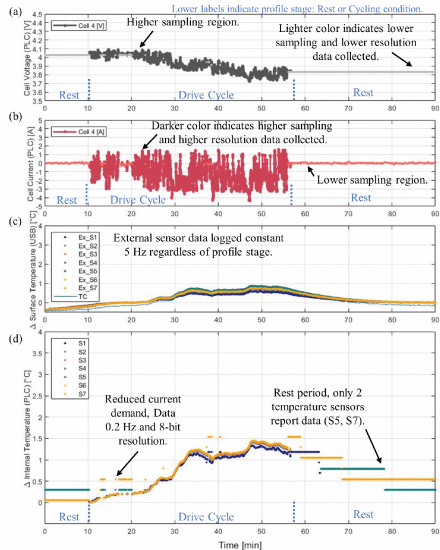WMG Insights
Novel signal processing in smart cell technology
Governments and legislatures around the world are committed to the electrification of transport and energy sectors in response to ever increasing political and social pressure to achieve Net Zero and decarbonisation targets. Rechargeable lithium-ion batteries (LiB) which underpin the design of energy storage systems (ESS) employed within automotive and wider electrical generation sectors are set to play a key role in the UK’s electrification strategy.
The successful integration of an ESS capable of managing available battery power and energy and controlling the increasingly complex ancillaries is heavily reliant on a battery management system with advanced monitoring and signal processing capabilities. Novel examples of signal processing within battery management systems include the analysis of big data, artificial neural networks in machine learning and the demodulation and analysis of sensor signals utilised in autonomous driving and battery state estimation.
Smart Cells incorporate a variety of sensing methods, are capable of multi-point measuring and can serve as part of a distributed battery management system. The integration of a micro-processor offers the opportunity to explore novel communication methods such as Powerline Communication (PLC) and enables the acquisition and pre-processing of sensor data at cell level. Consequently, Smart cells can functionally deliver previously unrealised insight into heterogeneous thermal behaviour at cell interfaces, enhancing thermal management and safety considerably whilst reducing both the load on the communication platform and the computational burden on a central battery management system (BMS).
Smart cell processing involves acquiring data from a range of sensors and extracting the relevant information. For example, in our design of a thermistor instrumented Smart cell (https://doi.org/10.1109/ACCESS.2021.3131382), up to 7 sensors are positioned along the core of the cell. Features of interest, such as hottest and coolest points (and locations) can be calculated from the array of sensors and transmitted to the central BMS to optimise control of the pack temperature and thermal management system.
To understand cell performance and provide early warning of cell failure, features such as brief spikes or fluctuations in temperature are of interest. Smart cells employ adaptive sampling; meaning during periods of inactivity or rest a low sample rate (0.2Hz) can be configured, however, if an event of interest occurs (i.e., a temperature variation caused by external heating, or a sudden pulse demand in current) an increased rate of transmission (20Hz) is triggered ensuring key information is recorded and handled by the central BMS for diagnostic and prognostic purposes.

Figure 1: Adaptive sampling over a drive cycle (a) voltage, (b) current, (c) external temperature and (d) internal temperature
Our smart cells are also instrumented with Distributed optical fibre sensors (DOFSs) for advanced battery characterisation (https://doi.org/10.1016/j.jpowsour.2021.230957). Optical frequency domain reflectometry (OFRD - a specific Rayleigh Backscattering DOFS) employs a tuneable laser source (TLS), the output frequency of which is linearly tuned in time. As the light signal propagates through the optical system, redistributed backscattered light from the test fibre interferes with the light signal in a reference arm resulting in a beat signal which is digitised. Digital signal processing is essential in demodulating and mapping variations in backscattered light against specific test fibre locations. This in turn provides local information along the test fibre that can be used to measure temperature, strain, and vibration.
An undesirable phenomenon in OFDR is non-linear sweeping of the laser source which introduces noise to the system resulting in frequency uncertainty and a broadening in spatial resolution. Novel signal processing techniques including equal frequency resampling have enabled the Optics team to counteract non-linear laser effects through the compensation of inaccurate estimation of the frequency distribution. A process involving two steps: firstly, the instantaneous optical frequency distribution of the laser is calculated using an auxiliary interferometer and Hilbert transform, after which the frequency interval is optimised by the overall frequency distribution supressing signal noise, reducing uncertainty in distributed sensing and optimising measurement resolution.
To conclude, signal processing is a key aspect of both Smart cell technology and by extension next generation BMS where a distributed architecture will enable control and monitoring functions to be implemented locally for optimal safety and performance.
10. Jiang, Y. Yu, J. Huang, W. Cai & J. Marco, Li-ion battery temperature estimation based on recurrent neural networks, Science China Technological Services, 64, 2021, DOI: https://doi.org/10.1007/s11431-020-1736-5.
11. Vincent, B. Gulsoy, J. Sansom, J. Marco, A Smart Cell Monitoring System based on Power Line Communication - Optimization of Instrumentation and Acquisition for Smart battery management, IEEE Access 2021, 9, 2021, DOI: https://doi.org/10.1109/ACCESS.2021.3131382.
12. Guo, G. Han, J.Yan, D. Greenwood, J. Marco, Ultimate Spatial Resolution Realisation in Optical Frequency Domain Reflectometry with Equal Frequency Resampling, Sensors, 14, https://doi.org/10.3390/s211446322021.
